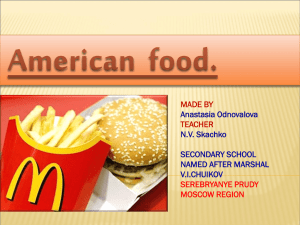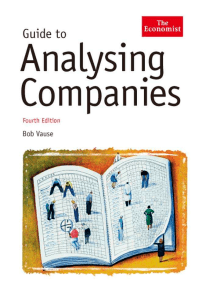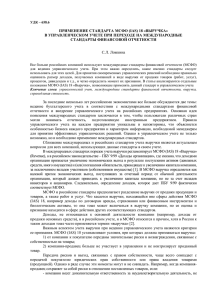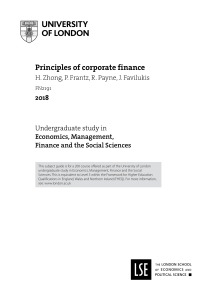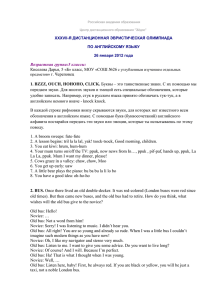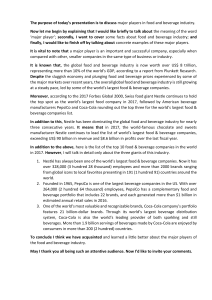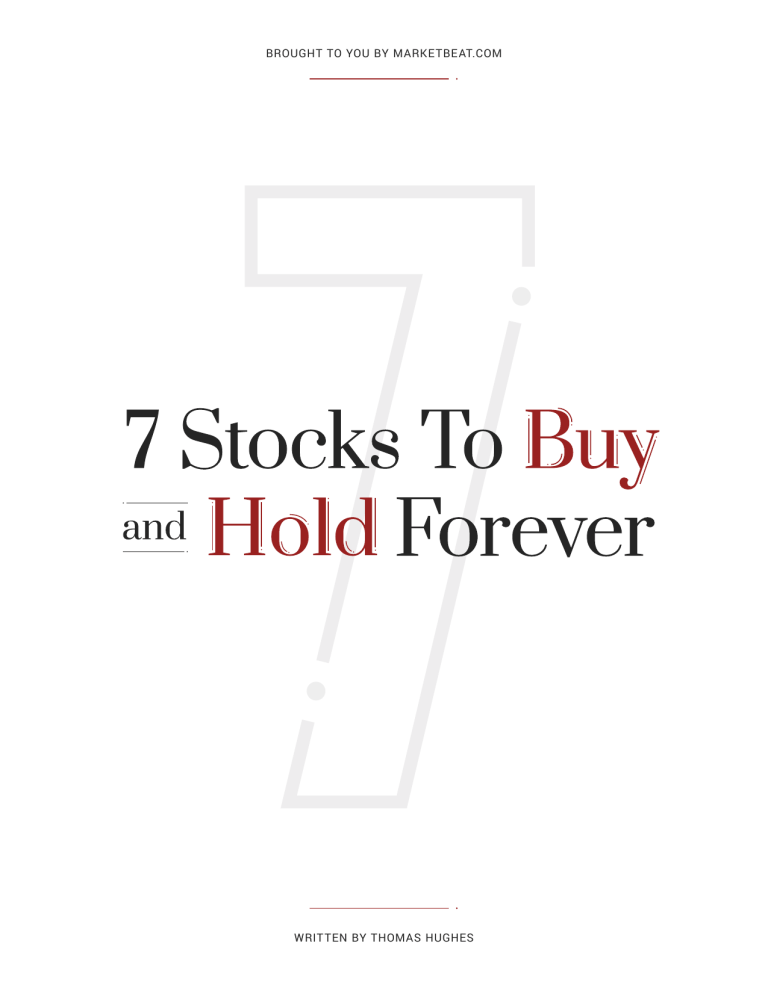
BROUGHT TO YOU BY MARKETBEAT.COM WRITTEN BY THOMAS HUGHES Buy And Hold, It’s The Warren Buffett Way Buy and hold is the easiest strategy of investment there is. The idea is simple, buy a stock and hold it forever while it helps make you rich. In theory, it’s a great concept but in practice buy and hold is a little bit harder to do. Great investors like Warren Buffet have succeeded where others haven’t simply because they take the time to ferret out the best-run companies in the best markets. The difference between Warren Buffet and the average investor is that it’s Warren’s job to ferret out those companies. Most average investors are busy with work and family and don’t have the time, that’s where we come in. In this eBook, we’ll give in-depth detail to the what, who, and why to buy for seven (7) of the best buy-and-hold-forever stocks on the market today. Dividends Are What Make A Stock An Asset Dividends are at the heart of what makes a great buy-and-hold-forever stock. Dividends are payments from the business, usually earnings, to its shareholders, and the difference between investing and speculation. You want to invest in assets that pay you to own them, not speculate on some future growth target that may or not be reached. When it comes to dividends, stability is the #1 concern, distribution growth the 2nd. You always want to be sure your payouts are safe for two reasons. The first is that you don’t want your yieldon-investment, the original yield on the stocks you’ve purchased, to ever fall. The second is that you want to protect your capital and dividend decreases, pauses, and suspensions are not the way to do that. Regarding dividend growth, dividend growth is a sure path to ever-increasing returns regarding yield and capital gains. A stock that is in a cycle of dividend-growth usually sees its share prices move higher to match. The idea is if the stock is worth X while paying Y, X should increase relative to Y over time. 2 What Makes A Stock Worthy Of Holding Forever? When you think about it, just about any company could be a buy-and-hold-forever kind of stock. But they aren’t. That’s what makes growth investing so difficult. For us, the best place to begin a search for a company that will last forever is with a group of companies that have been around for, well, just about forever. The best group to start with is neither industry nor a sector but a quality of company known as Dividend King. Dividend Kings are stocks that have been paying and increasing their dividend payouts for at least 50 years. 50 years is a long time and helps establish a few basic facts about the stock before you even consider individual companies. The first is that the business is blue-chip quality and able to withstand economic and market ups and downs. Think about it, over the last 50 years Dividend Kings have seen countless wars, numerous disruptions, dozens of market sell-offs, a handful of recessions, and not only paid but increased the dividend every year. Pretty impressive. The second is that, in order to be a Dividend King, the company and management are committed to dividend payments and ever-increasing distribution amounts. That’s important because some companies will raise a dividend in times of good only to lower it in times of downturn. That’s important for stability, not only of the payment but of share prices. In 2020, there are 29 Dividend Kings across a diverse range of sectors so there are plenty to choose from. The one drawback to the Dividend Kings is that many yield lower than the average S&P 500 company. In that vein, it may be better to invest in an S&P 500 index fund but it’s not. It’s better to target the higher-yielding ones like Altria, Federal Realty, 3M, and Coca Cola. Of these, Coca Cola stands out as a favorite because of its positioning within the consumer market, consumer, and economic trends in the post-pandemic world. 3 1 The Coca-Cola Company (KO) 57 YEARS OF SUSTAINED, CONSECUTIVE DIVIDEND INCREASES The Coca-Cola Company is the parent to all-things Coke related. Everything from the soda in your glass to the signs on the street generates revenue for this company in some way. Unlike competitors Pepsico and Keurig-Dr. Pepper which have had to turn to mergers and productdiversification to fuel growth, the Coca-Cola Company is still a pure-play on beverages. And it’s been increasing its dividend on a regular, consistent, annual basis for 57 years. In addition to Coke, the beverage company manufactures, markets, and sells various nonalcoholic beverages worldwide. The Coca- Cola Company provides sparkling soft drinks; water, enhanced water, and sports drinks; juice, dairy, and plant-based beverages; tea and coffee; and energy drinks to consumers worldwide. The Coca-Cola Company also offers beverage concentrates and syrups, as well as fountain syrups to fountain retailers, such as restaurants and convenience stores. The company sells its products under the Coca-Cola, Diet Coke/Coca-Cola Light, Coca-Cola Zero Sugar, Fanta, Fresca, Schweppes, Sprite, Thums Up, Aquarius, Ciel, Dasani, glaceau smartwater, glaceau vitaminwater, Ice Dew, I LOHAS, Powerade, Topo Chico, AdeS, Del Valle, fairlife, innocent, Minute Maid, Minute Maid Pulpy, Simply, ZICO, Ayataka, Costa, dogadan, FUZE TEA, Georgia, Gold Peak, HONEST TEA, and Kochakaden brands. THE EARNINGS OUTLOOK: Other than a small hiccup in calendar 2020 related to the COVID-19 pandemic The Coca-Cola Company is on track to deliver sustained, incremental, YOY growth in both revenue and EPS for the foreseeable future. Revenue growth should trend in the 7% to 10% range with EPS running at a much higher 10% to 20% through 2025. THE DIVIDEND: Coca-Cola Company is a Dividend King with 57 years of consecutive distribution increases to its credit. The stock is yielding a nice 3.63% while trading near $45 with every expectation of future increases. The payout ratio, a basic measure of the dividend’s sustainability, is running a bit high at 87% of the calendar 2020 EPS but there is a catch. The company’s cash position is more than sufficient to cover any hiccups in business and the outlook for next year is upbeat. Based on consensus, the payout ratio will fall to a more reasonable 78%. Any worry left at this point should be laid to rest by the balance sheet. The company’s cash position, debt-management, and coverage ratios ensure this dividend is dependable. 4 2 Pepsico Inc (PEP) 48 YEARS OF SUSTAINED, CONSECUTIVE DIVIDEND INCREASES There is a reason why Pepsi is on this list and not just because of its 3.10% dividend yield. Some marketing genius, a long time ago, figured out that sales of both Coke and Pepsi were higher when the products were offered side by side. The idea is that, if faced with a Coke or a Pepsi machine, the decision is between having a soda or not having a soda. When Coke and Pepsi machines are side by side the decision becomes “will I have a Pepsi or a Coke?” At that point the consumer has already decided that soda will in fact be purchased, now it’s just a matter of choice. Unlike Coke, PepsiCo, Inc. operates as a food and beverage company worldwide. The company operates through seven segments manufacturing and selling branded dips, cheese-flavored snacks, and tortillas, as well as corn, potato, and tortilla chips; cereals, rice, pasta, mixes and syrups, granola bars, grits, oat squares, oatmeal, rice cakes, simply granola, and side dishes; beverage concentrates, fountain syrups, and finished goods; ready-to-drink tea, coffee, and juices; and dairy products. Pepsico Inc provides its products primarily under the Cheetos, Doritos, Fritos, Lay’s, Ruffles, Tostitos, Aunt Jemima, Cap’n crunch, Life, Pasta Roni, Quaker Chewy, Quaker, Rice-A-Roni, Aquafina, Diet Mountain Dew, Diet Pepsi, Gatorade, Mountain Dew, Pepsi, Propel, Sierra Mist, Tropicana, 7UP, Gatorade, Pepsi, and Pepsi Black brands. The company serves retailers and consumers through a network of direct-store-delivery, customer warehouse, and distributor networks, as well as directly to consumers through e-commerce platforms and retailers. The company was founded in 1898 and is headquartered in Purchase, New York. THE EARNINGS OUTLOOK: The earnings outlook for Pepsico Inc is much the same as for The Coca-Cola Company. Aside from a small and perhaps negligible hiccup in calendar 2020 the company is on track to produce incremental sustained growth in both EPS and revenue for the foreseeable future. Growth in both EPS and revenue will lag that of Coke but EPS growth averaging 10% for the next five years isn’t bad for any company with annual revenue in the $70 billion range. THE DIVIDEND: While not a true Dividend King Pepsico Inc is a 3%-paying Dividend Aristocrat on the verge of Kingship. This company has been steadily increasing its distribution for 48 years and clearly on track to make it a 49th. The payout ratio is a bit lower than Coke’s at 77% of this year’s EPS and 70% next and those figures are backed up with a solid balance sheet. The balance sheet is almost as pristine as Coke’s. If not for Pepsico’s semi-aggressive acquisitionfocused growth strategy cash and coverage would be equally good so there is a trade-off. Regardless, cash, debt, and coverage ratios are all in-line with sound financial standing so no worry about the dividend or future increases here. 5 3 Clorox (CLX) A DIVIDEND PRINCE WITH A DENTED CROWN Clorox is the single-best positioned consumer staples stock in the market today. The company is the owner of the single most recognizable consumer disinfectant brand in the world and seeing mad demand because of the COVID-19. A company spokesperson revealed demand for some products exceeded 500%, a situation that is not likely to change in the near future. What many don’t know is that Clorox is the owner of several other consumer brands that can be labeled essential for pantry-loading and stay-at-home, as well as for life in general. Among them are Clorox, Formula 409, Liquid-Plumr, Pine-Sol, S.O.S, and Tilex brands; naturally derived products under the Green Works brand; and professional cleaning, disinfecting, and food service products under the CloroxPro, Dispatch, Clorox Healthcare, Hidden Valley, and KC Masterpiece brands. Clorox also provides charcoal products under the Kingsford and Match Light brands; bags, wraps, and containers under the Glad brand; cat litter products under the Fresh Step, Scoop Away, and Ever Clean brands; and digestive health products under the RenewLife brand. Clorox also markets waterfiltration systems and filters under the Brita brand; natural personal care products under the Burt’s Bees brand; and dietary supplements under the Rainbow Light, Natural Vitality, and Neocell brands THE EARNINGS OUTLOOK: Unlike many other companies Clorox will not only see revenue growth in calendar 2020 but revenue growth acceleration. The boost in revenue is not expected to slow for many reasons, most tied to the pandemic. Aside from increased demand for cleaners, disinfectants, and household products Clorox is now in demand as a partner for other businesses. Several big-name companies including an airline and a cruise-line have already partnered with Clorox to ensure sanitary conditions for their clients and customers. THE DIVIDEND: Clorox isn’t a Dividend King or even a Dividend Aristocrat but that doesn’t matter. The company’s history of dividend payments shows 31 years of regular increases with no decreases ever. Most recently, Clorox has managed to sustain 18 years of distribution increase which puts it firmly on track for Dividend Aristocrat status (25 years of sustained increases). Regardless, the 2.0% yield is supported by a low 65% payout ratio and that ratio is projected to get smaller (assuming no more dividend increases). 6 4 Abbott Laboratories (ABT) AN ARISTOCRAT BY ANY OTHER NAME WOULD PAY AS WELL Abbott Laboratories is one of our favorite stocks of all-time. The company is in business as a staplehealth care company servicing the needs of consumers and professionals alike. Products range from dietary supplements through medical devices and therapies and its future success is all but assured. Not only is America’s (and the world’s) population growing, it is aging and spending more and more on healthcare on a per capita basis. All things that bode well for Abbott Laboratories’ future earnings, dividend payments, and future distribution increases. THE EARNINGS OUTLOOK: There is nothing to not like about Abbott Laboratories’ outlook for earnings. The company will see a slight hiccup in 2020 that may not even be felt, beyond that the outlook is for steady moderate to robust growth for the foreseeable future. Regarding 2020, the current consensus for revenue is -1.85%. Based on the first-quarter results, the consensus for 2nd quarter results, and the comparison to last year’s 3rd and 4th quarter this company will easily beat consensus. THE DIVIDEND: You like Abbott Laboratories because of the business, you love it because of the dividend. Abbott is one of the best dividend-paying stocks on the market, not matter the short six-year history of increases. What the stats don’t reveal is that Abbott has only ever increased its dividend. Yes, if you look at the history there was a big distribution cut in 2013 but there is a mitigating factor. In 2013 Abbott spun off its bio-pharma unit creating AbbVie. Shareholders of Abbott got not only shares in this new company but also stock in a new dividend-grower. If you count the years of increases before the spin-off, the years of increases after the spin-off, and 7 years of increases from AbbVie, Abbott more than qualifies for Aristocrat status. DIVIDEND GROWTH HISTORY AbbVie Spin Off 7 5 AbbVie (ABBV) A DIVIDEND ARISTOCRAT IN THE MAKING AbbVie Inc. is the perfect complement to Abbott Laboratories and a high-yield dividend payer. The company discovers, develops, manufactures, and sells pharmaceuticals globally. The companies leading drugs include HUMIRA, SKYRIZI, RINVOQ, IMBRUVICA, VENCLEXTA, VIEKIRA PAK, TECHNIVIE, SYNAGIS, and CREON among others. The company was incorporated in 2012 as part of its spin-off from Abbott Laboratories and is based in North Chicago, Illinois. THE EARNINGS OUTLOOK: AbbVie has one of the best outlooks for earnings of any stock on the market. The company is expected to produce high-double-digit EPS and Revenue growth in 2020 and 2021 with the longer-term outlook equally robust. Revenue is supported by a robust portfolio of treatments and a flush pipeline that ensures new treatments will be available long into the future. Oddly enough, AbbVie trades at a relatively low multiple for such a high-growth stock so there is a value to be had as well. THE DIVIDEND: AbbVie is a budding Dividend Aristocrat and well-positioned to effect aggressive distribution increases for many years to come. The stock yields about 4.75% with shares prices near $99 so it is a nice addition to any income portfolio. The payout ratio is low at 45% and will trend lower over the coming years assuming no further increases are forthcoming. Regarding increases, the 5-year CAGR is running above 20% and likely to remain high for the foreseeable future. Assuming the consensus figures for next year are correct, AbbVie will have to up the payout by 14% just to keep the payout ratio flat. 8 6 Apple (AAPL) IF YOU DON’T OWN APPLE YOU NEED TO Technology is one of the most important aspects of our lives. If that wasn’t the case in the preCOVID world it certainly is now. The problem with tech investing is that it is hard to know what tech to buy, which tech will last, and not many pay dividends. And yet tech is still an important part of our lives and should be included in any buy-and-hold forever portfolio. That’s why we like Apple. Apple embodies everything there is to love about tech and more. It is a consumer company with its finger on the pulse of what people want. If you can’t count on a certain tech to last forever you can count on the world’s largest consumer tech company. And don’t forget about the cash pile. Apple is the most capitalized company on the planet with billions in cash sitting around just waiting to be used, or returned to shareholders. A look at the balance sheet is jaw-dropping. If you want to know what a fortress-balance sheet is, this is it. The company is sitting on more than $21 in cash per share, the debt to free-cash-flow ratio is running near two (2), and the coverage ratio is above 20. Bottom line, Apple is in no danger of anything other than laziness, and there is no indication this company is ready to rest on its laurels. THE EARNINGS OUTLOOK: Apple was among the very first to begin shuttering stores when the COVID-19 pandemic broke out and it will not emerge unscathed. That said, the company’s growth in 2020 will only be reduced, not eliminated, to around 2.0%. Looking forward, the consensus is Apple will rebound strongly from the pandemic and emerge with greater market share and re-invigorated demand. The longer-term outlook is also bullish with a mid-singledigit outlook for revenue and a high-single-digit outlook for earnings growth for the next ten years. THE DIVIDEND: Apple is by no means a high-yielding stock, the payout is less than 1.0%, but it has a dividend and it is the safest payout on Wall Street. Not even considering the cash position, the company is only paying about 25% of earnings with very little debt or other obligation to hamper payments. Apple has also established itself as a dividend-grower having increased the payout each of the 7 years since the dividend was initiated. The best part is that Apple has been increasing at a low-double-digit rate, near 10%, so investors can count on an increasing yield-on-investment long into the future. 9 7 KLA Corporation (KLAC) BUILDING THE INFRASTRUCTURE OF TECHNOLOGY KLA Corporation is a play on tech that doesn’t depend on the tech itself. At least not the forwardfacing consumer-tech people tend to see and investors tend to gush over. Building on the idea that consumers are fickle, that tech rapidly changes and knowing which tech companies will stand the test of time KLA Corporation is a play on the infrastructure of tech. If you’re thinking semiconductors and chips you’re close but dig a little deeper. KLA Corporation builds the machines and components the chipmakers use to make their chips. We may not know which tech companies will last, or what kind of chips we’ll need next year, but we will always need the machines and technology to build chips, for whatever purpose they are for. KLA Corporation is more than a blue-chip in this regard, it is fundamental to the entire tech ecosphere. Without chips, there is no tech. THE EARNINGS OUTLOOK: Demand for chips and chip-making supplies can be seen in KLA Corporation’s results. The company is on track to deliver 25% revenue growth in 2020 despite the pandemic. Looking forward, growth will slow a bit in 2021 before resuming near 10% annually the year after. Longer-term, KLA Corporation is expecting to see steady if not robust growth for many years driven by the accelerating shift to digital. The pandemic, if nothing else, has proven the need and utility of the internet and that is fueling a faster pace of adoption than seen previously. Add to that an expected boom related to 5G and the Internet of Things and KLA Corporation’s long-term health becomes even more certain. THE DIVIDEND: I wouldn’t call KLA Corporation an exciting dividend or a high-yield dividend but I would call it incredibly stable. The stock yields about 1.5%, a bit shy of the broad market average, but the forecast for distribution increases is excellent. Starting with the balance sheet, KLA Corporation is reminiscent of Apple in that it carries a large cash balance, a highcoverage ratio, and low levels of debt. The history of payouts shows 10 years of aggressive growth that has the CAGR running above 15% and the payout ratio at a mere 33%. Looking forward, dividend-growth investors can anticipate many more years of distribution increases. 10

